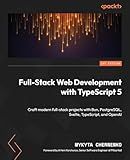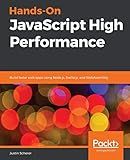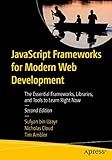Best Tools for Code Splitting in Svelte to Buy in December 2025

Full-Stack Web Development with TypeScript 5: Craft modern full-stack projects with Bun, PostgreSQL, Svelte, TypeScript, and OpenAI



Hands-On JavaScript High Performance: Build faster web apps using Node.js, Svelte.js, and WebAssembly



JavaScript Frameworks for Modern Web Development: The Essential Frameworks, Libraries, and Tools to Learn Right Now


Code splitting is a technique used to improve performance in web applications by breaking down the code into smaller chunks or modules. In the context of Svelte, code splitting involves splitting the application code into smaller pieces that can be loaded on-demand, rather than loading the entire application code upfront.
To implement code splitting in Svelte, you can make use of dynamic imports. Dynamic imports allow you to import modules on-demand, which helps in separating the application code into smaller chunks that can be loaded when needed. Here's how you can do it:
- Identify the parts of your code that can be split into separate chunks. These can be large components, routes, or any other logical separation points in your application.
- In those parts of the code, instead of using a regular import statement, use the import() function provided by JavaScript. For example, instead of import MyComponent from './components/MyComponent.svelte';, you would use const MyComponent = import('./components/MyComponent.svelte');.
- The import() function returns a promise that resolves to the requested module. To use the imported component, you need to await the promise and then use the default property of the resolved module. For example, const MyComponent = (await import('./components/MyComponent.svelte')).default;.
- Make sure to handle any errors that might occur during dynamic imports using try-catch blocks or error handling mechanisms provided by Svelte.
- Finally, when rendering the component, use the svelte:component special element along with a conditional statement to dynamically render the component. For example:
Load Component
{#if showComponent} <svelte:component this={MyComponent} /> {/if}
By splitting your code into smaller, on-demand loaded chunks, you can optimize the initial load time of your application. This helps in reducing the bundle size and improving the overall performance, especially for larger applications.
What is the impact of code splitting on SEO optimization in Svelte?
Code splitting, also known as dynamic imports, is a technique used to split the source code into smaller chunks and load them asynchronously when necessary. It can have both positive and negative impacts on SEO optimization in Svelte.
Positive impact:
- Improved initial page load time: By splitting the code into smaller chunks, only the necessary code is loaded initially. This reduces the initial payload size and improves the page load time, which can positively impact SEO rankings.
Negative impact:
- Delayed rendering: As code splitting involves loading code asynchronously, there can be a delay in rendering the page content until all the necessary code chunks are loaded. This delay can hinder the search engine crawlers' ability to fully render and understand the content of the page, potentially affecting SEO.
To mitigate the negative impact and optimize SEO while using code splitting in Svelte, consider the following:
- Server-side rendering (SSR): Implement SSR to pre-render the initial page content on the server, ensuring search engine crawlers have access to fully rendered content regardless of any code splitting delays.
- Proper chunk optimization: Organize code splitting in a way that important SEO-relevant content and functionality are loaded early or together with the initial chunk. This ensures that search engines can access critical content even if other non-essential components are loaded later.
- Use meta tags: Utilize appropriate meta tags like the description tag to provide search engines with a summary of the page's content. This helps search engines understand the context and relevance of the page while it is being loaded or if there are any rendering delays.
- Provide alternative content: Display alternative content, such as loading indicators or placeholders, during code loading delays. This helps maintain a good user experience and provides search engines with some content to index, even if it is not the final rendered content.
Overall, while code splitting in Svelte can have some impact on SEO optimization, proper implementation and optimization techniques can help mitigate any potential negative impact and ensure search engines can effectively crawl and understand the content of the page.
How to set entry points for code splitting in Svelte?
In Svelte, code splitting is achieved using dynamic imports. To set entry points for code splitting, you can follow these steps:
- Identify the parts of your code that you want to split into separate chunks. These can be components, modules, or any other logical divisions.
- Use the dynamic import syntax to import these parts wherever they are needed. For example, instead of importing a component directly, you will use the dynamic import syntax like this:
const MyComponent = import('./components/MyComponent.svelte');
- Wrap the code that uses the dynamically imported part in a {#await} block to handle the async loading. For example:
{#await MyComponent}
- Repeat the above steps for all the parts you want to split. This will ensure that the code is loaded on-demand when needed.
- Build your Svelte project using a bundler like Rollup or webpack to generate the separate chunks. The bundler will automatically split your code based on the dynamic imports.
By following these steps, you can set entry points for code splitting in Svelte and optimize the loading and execution of your application.
What is code splitting and why is it important for performance?
Code splitting is a technique in software development where a large codebase is divided into smaller chunks, which can be loaded dynamically as needed. This allows only the required code to be loaded by the user's browser or runtime environment, resulting in improved performance.
One key reason code splitting is important for performance is reducing initial page load times. When a web or mobile application is first loaded, the entire codebase can be quite large, leading to longer load times. By splitting the code, the application can be divided into smaller, more manageable chunks that can be loaded incrementally. This allows the user to start interacting with the application faster, as only the essential code needed for the initial view or feature is loaded initially.
Code splitting also helps in reducing the amount of redundant code downloaded by users. In applications with multiple views or features, not all users may access all the functionality. Without code splitting, the entire codebase would need to be loaded, even if certain parts of it may not be used. By dynamically loading chunks of code only when required, the overall amount of code downloaded can be reduced, resulting in faster load times and improved performance.
Additionally, code splitting can improve the caching and reusability of code. By splitting code into smaller modules, it becomes easier to cache and reuse those modules across different pages or views of an application. This can further enhance performance by reducing the need to re-download or recompile code that has already been loaded.
In summary, code splitting is important for performance as it reduces initial page load times, downloads only the required code, and improves code caching and reusability. By optimizing the loading and execution of code, applications can provide a faster and smoother user experience.
How to prefetch or preload split chunks in Svelte?
In Svelte, you can prefetch or preload split chunks by using dynamic imports and the xlink attribute on script tags. Here's how you can do it:
- Wrap your dynamic import statement with an await and store the result in a variable:
let importedComponent = null;
async function loadComponent() { importedComponent = await import('./path/to/component.svelte'); }
- Create a script tag dynamically and set its xlink attribute to the path of your split chunk. You can add this code wherever you want to trigger the prefetching/preloading:
function prefetch() { const script = document.createElement('script'); script.setAttribute('xlink', 'path/to/split-chunk.js'); document.head.appendChild(script); }
- In your markup, create a button or any other element that calls the prefetch() function when clicked:
Prefetch Component
When the button is clicked, the split chunk file will be prefetched or preloaded.
Note: Preloading is only effective if you have a specific user interaction triggering it (e.g., a button click). Browsers typically prioritize preloading resources that are likely to be needed soon after the user interacts with your application.
How to implement code splitting without affecting existing Svelte components?
To implement code splitting in a Svelte app without affecting existing components, you can follow these steps:
- Identify the parts of your app that can be split into separate chunks. These could be large third-party libraries or sections of your app that are rarely used.
- Install a code splitting library like svelte-dynamic-import or rollup-plugin-svelte-split. These libraries provide a way to split your code into separate chunks based on dynamic imports.
- Configure the code splitting library in your build setup. This will depend on the specific library you choose, but typically involves adding a plugin to your bundler (e.g., Rollup or webpack) configuration.
- Load the split components dynamically in your app. Instead of importing the entire component, import it dynamically using the code splitting library. For example:
import { afterUpdate } from 'svelte';
let SomeComponent;
afterUpdate(() => { // Dynamically load the split component if (!SomeComponent) { import('./SomeComponent.svelte').then((module) => { SomeComponent = module.default; }); } });
- Use the dynamically loaded component in your app as needed. You can conditionally render the component once it has been loaded:
{#if SomeComponent} {/if}
Make sure to handle cases where the component fails to load or encounters an error. You can use a loading spinner or show an error message to the user, depending on your specific requirements.
By following these steps, you can implement code splitting in your Svelte app without affecting the existing components. Only the split code will be loaded when needed, reducing the initial bundle size and improving the performance of your app.
How to track code splitting statistics in Svelte?
To track code splitting statistics in Svelte, you can use the Svelte Rollup plugin called rollup-plugin-visualizer. This plugin helps to visualize the sizes of the generated chunks in your bundle.
Here are the steps to track code splitting statistics in Svelte using rollup-plugin-visualizer:
- Install the plugin by running the following command in your project's root folder: npm install --save-dev rollup-plugin-visualizer
- Open your rollup.config.js file, which is located in the root folder of your project.
- Import the visualizer plugin at the top of the file: import visualizer from 'rollup-plugin-visualizer';
- Add the visualizer plugin to the plugins array in your rollup.config.js file: export default { // ... plugins: [ // ... other plugins visualizer() ] } This configures the visualizer plugin to run after all the other Rollup plugins in the pipeline.
- Build your Svelte project by running the usual build command (for example, npm run build).
- Once the build is complete, a new file called stats.html will be generated in your project's root folder.
- Open the stats.html file in your browser to visualize the code splitting statistics. It will show a detailed breakdown of the generated chunks, their sizes, and their dependencies.
By following these steps, you can easily track code splitting statistics in Svelte using the rollup-plugin-visualizer plugin.
